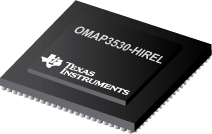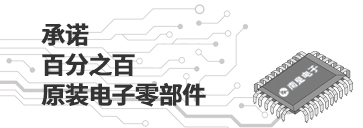

OMAP3530-HIREL是TI公司的一款媒体处理器产品,OMAP3530-HIREL是OMAP3530-HiRel 应用处理器,本页介绍了OMAP3530-HIREL的产品说明、应用、特性等,并给出了与OMAP3530-HIREL相关的TI元器件型号供参考。
OMAP3530-HIREL - OMAP3530-HiRel 应用处理器 - 媒体处理器 - 数字信号处理器 - TI公司(Texas Instruments,德州仪器)
OMAP3525 and OMAP3530 high-performance, applications processors are based on the enhanced OMAP™ 3 architecture.
The OMAP™ 3 architecture is designed to provide best-in-class video, image, and graphics processing sufficient to support the following:
Streaming video 3D mobile gaming Video conferencing High-resolution still imageThe device supports high-level operating systems (OSs), such as:
Linux Windows CEThis OMAP device includes state-of-the-art power-management techniques required for high-performance mobile products.
The following subsystems are part of the device:
Microprocessor unit (MPU) subsystem based on the ARM Cortex™-A8 microprocessor IVA2.2 subsystem with a C64x+ digital signal processor (DSP) core POWERVR SGX™ subsystem for 3D graphics acceleration to support display and gaming effects (3530 only) Camera image signal processor (ISP) that supports multiple formats and interfacing options connected to a wide variety of image sensors Display subsystem with a wide variety of features for multiple concurrent image manipulation, and a programmable interface supporting a wide variety of displays. The display subsystem also supports NTSC/PAL video out. Level 3 (L3) and level 4 (L4) interconnects that provide high-bandwidth data transfers for multiple initiators to the internal and external memory controllers and to on-chip peripheralsThe device also offers:
A comprehensive power and clock-management scheme that enables high-performance, low-power operation, and ultralow-power standby features. The device also supports SmartReflex&trade adaptative voltage control. This power management technique for automatic control of the operating voltage of a module reduces the active power consumption. Memory stacking feature using the package-on-package (POP) implementation (CBB and CBC packages only)OMAP25 and OMAP3530 devices are available in a 515-pin s-PBGA package (CBB suffix), 515-pin s-PBGA package (CBC suffix), and a 423-pin s-PBGA package (CUS suffix). Some features of the CBB and CBC packages are not available in the CUS package.
Table 1-1 lists the differences between the CBB, CBC, and CUS packages.
- OMAP325 and OMAP3530 Applications Processor:
- OMAP™ 3 Architecture
- MPU Subsystem
- Up to 600-MHz ARM Cortex™-A8 Core
- NEON™ SIMD Coprocessor
- High Performance Image, Video, Audio (IVA2.2™) Accelerator Subsystem
- Up to 520-MHz TMS320C64x+™ DSP Core
- Enhanced Direct Memory Access (EDMA) Controller (128 Independent Channels)
- Video Hardware Accelerators
- POWERVR SGX™ Graphics Accelerator (OMAP3530 Device Only)
- Tile Based Architecture Delivering up to 10 MPoly/sec
- Universal Scalable Shader Engine: Multi-threaded Engine Incorporating Pixel and Vertex Shader Functionality
- Industry Standard API Support: OpenGLES 1.1 and 2.0, OpenVG1.0
- Fine Grained Task Switching, Load Balancing, and Power Management
- Programmable High Quality Image Anti-Aliasing
- Fully Software-Compatible With C64x and C64x and ARM9™
- Commercial and Extended Temperature Grades
- Advanced Very-Long-Instruction-Word (VLIW) TMS320C64x+™ DSP Core
- Eight Highly Independent Functional Units
- +Six ALUs (32-/40-Bit), Each Supports Single 32-Bit, Dual 16-Bit, or Quad 8-Bit Arithmetic per Clock Cycle
- Two Multipliers Support Four 16 × 16-Bit Multiplies (32-Bit Results) per Clock Cycle or Eight 8 x 8-Bit Multiplies (16-Bit Results) per Clock Cycle
- Load-Store Architecture With Non-Aligned Support
- 64 32-Bit General-Purpose Registers
- Instruction Packing Reduces Code Size
- All Instructions Conditional
- Additional C64x+™ Enhancements
- Protected Mode Operation
- Exceptions Support for Error Detection and Program Redirection
- Hardware Support for Modulo Loop Operation
- Eight Highly Independent Functional Units
- C64x+ L1/L2 Memory Architecture
- 32K-Byte L1P Program RAM/Cache (Direct Mapped)
- 80K-Byte L1D Data RAM/Cache (2-Way Set-Associative)
- 64K-Byte L2 Unified Mapped RAM/Cache (4-Way Set-Associative)
- 32K-Byte L2 Shared SRAM and 16K-Byte L2 ROM
- C64x+ Instruction Set Features
- Byte-Addressable (8-/16-/32-/64-Bit Data)
- 8-Bit Overflow Protection
- Bit-Field Extract, Set, Clear
- Normalization, Saturation. Bit-Counting
- Compact 16-Bit Instructions
- Additional Instructions to Support Complex Multiplies
- ARM Cortex™-A8 Core
- ARMv7 Architecture
- Trust Zone®
- Thumb®-2
- MMU Enhancements
- In-Order, Dual-Issue, Superscalar Microprocessor Core
- NEON™ Multimedia Architecture
- Over 2x Performance of ARMv6 SIMD
- Supports Both Integer and Floating Point SIMD
- Jazelle® RCT Execution Environment Architecture
- Dynamic Branch Prediction with Branch Target Address Cache, Global History Buffer, and 8-Entry Return Stack
- Embedded Trace Macrocell (ETM) Support for Non-Invasive Debug
- ARMv7 Architecture
- ARM Cortex™-A8 Memory Architecture:
- 16K-Byte Instruction Cache (4-Way Set-Associative)
- 16K-Byte Data Cache (4-Way Set-Associative)
- 256K-Byte L2 Cache
- 112K-Byte ROM
- 64K-Byte Shared SRAM
- Endianess:
- ARM Instructions - Little Endian
- ARM Data – Configurable
- DSP Instruction/Data - Little Endian
- External Memory Interfaces:
- SDRAM Controller (SDRC)
- 16, 32-bit Memory Controller With 1G-Byte Total Address Space
- Interfaces to Low-Power Double Data Rate (LPDDR) SDRAM
- SDRAM Memory Scheduler (SMS) and Rotation Engine
- General Purpose Memory Controller (GPMC)
- 16-bit Wide Multiplexed Address/Data Bus
- Up to 8 Chip Select Pins With 128M-Byte Address Space per Chip Select Pin
- Glueless Interface to NOR Flash, NAND Flash (With ECC Hamming Code Calculation), SRAM and Pseudo-SRAM
- Flexible Asynchronous Protocol Control for Interface to Custom Logic (FPGA, CPLD, ASICs, etc.)
- Nonmultiplexed Address/Data Mode (Limited 2K-Byte Address Space)
- System Direct Memory Access (sDMA) Controller (32 Logical Channels With Configurable Priority)
- Camera Image Signal Processing (ISP)
- CCD and CMOS Imager Interface
- Memory Data Input
- RAW Data Interface
- BT.601/BT.656 Digital YCbCr 4:2:2 (8-/10-Bit) Interface
- A-Law Compression and Decompression
- Preview Engine for Real-Time Image Processing
- Glueless Interface to Common Video Decoders
- Histogram Module/Auto-Exposure, Auto-White Balance, and Auto-Focus Engine
- Resize Engine
- Resize Images From 1/4x to 4x
- Separate Horizontal/Vertical Control
- Display Subsystem
- Parallel Digital Output
- Up to 24-Bit RGB
- HD Maximum Resolution
- Supports Up to 2 LCD Panels
- Support for Remote Frame Buffer Interface (RFBI) LCD Panels
- 2 10-Bit Digital-to-Analog Converters (DACs) Supporting:
- Composite NTSC/PAL Video
- Luma/Chroma Separate Video (S-Video)
- Rotation 90-, 180-, and 270-degrees
- Resize Images From 1/4x to 8x
- Color Space Converter
- 8-bit Alpha Blending
- Parallel Digital Output
- Serial Communication
- 5 Multichannel Buffered Serial Ports (McBSPs)
- 512 Byte Transmit/Receive Buffer (McBSP1/3/4/5)
- 5K-Byte Transmit/Receive Buffer (McBSP2)
- SIDETONE Core Support (McBSP2 and 3 Only) For Filter, Gain, and Mix Operations
- Direct Interface to I2S and PCM Device and TDM Buses
- 128 Channel Transmit/Receive Mode
- Four Master/Slave Multichannel Serial Port Interface (McSPI) Ports
- High-Speed/Full-Speed/Low-Speed USB OTG Subsystem (12-/8-Pin ULPI Interface)
- High-Speed/Full-Speed/Low-Speed Multiport USB Host Subsystem
- 12-/8-Pin ULPI Interface or 6-/4-/3-Pin Serial Interface
- Supports Transceiverless Link Logic (TLL)
- One HDQ/1-Wire Interface
- Three UARTs (One with Infrared Data Association [IrDA] and Consumer Infrared [CIR] Modes)
- Three Master/Slave High-Speed Inter-Integrated Circuit (I2C) Controllers
- 5 Multichannel Buffered Serial Ports (McBSPs)
- Removable Media Interfaces:
- Three Multimedia Card (MMC)/ Secure Digital (SD) With Secure Data I/O (SDIO)
- Comprehensive Power, Reset, and Clock Management
- SmartReflex™ Technology
- Dynamic Voltage and Frequency Scaling (DVFS)
- Test Interfaces
- IEEE-1149.1 (JTAG) Boundary-Scan Compatible
- Embedded Trace Macro Interface (ETM)
- Serial Data Transport Interface (SDTI)
- 12 32-bit General Purpose Timers
- 2 32-bit Watchdog Timers
- 1 32-bit 32-kHz Sync Timer
- Up to 188 General-Purpose I/O (GPIO) Pins (Multiplexed With Other Device Functions)
- 6 5-nm CMOS Technology
- Package-On-Package (POP) Implementation for Memory Stacking (Not Available in CUS Package)
- Discrete Memory Interface (Not Available in CBC Package)
- Packages:
- 515-pin s-PBGA package (CBB Suffix), .5mm Ball Pitch (Top), .4mm Ball Pitch (Bottom)
- 515-pin s-PBGA package (CBC Suffix), .65mm Ball Pitch (Top), .5mm Ball Pitch (Bottom)
- 423-pin s-PBGA package (CUS Suffix), .65mm Ball Pitch
- 1.8-V I/O and 3.0-V (MMC1 only), 0.985-V to 1.35-V Adaptive Processor Core Voltage 0.985-V to 1.25-V Adaptive Core Logic Voltage Note: thee are default Operating Performance Point (OPP) voltages and could be optimized to lower values using SmartReflex™ AVS.
- Applications:
- Portable Navigation Devices
- Portable Media Player
- Advanced Portable Consumer Electronics
- Digital TV
- Digital Video Camera
- Portable Data Collection
- Point-of-Sale Devices
- Gaming
- Web Tablet
- Smart White Goods
- Smart Home Controllers
- Ultra Mobile Devices
- SDRAM Controller (SDRC)
POWERVR SGX is a trademark of Imagination Technologies Ltd. OMAP is a trademark of Texas Instruments. All other trademarks are the property of their respective owners.







